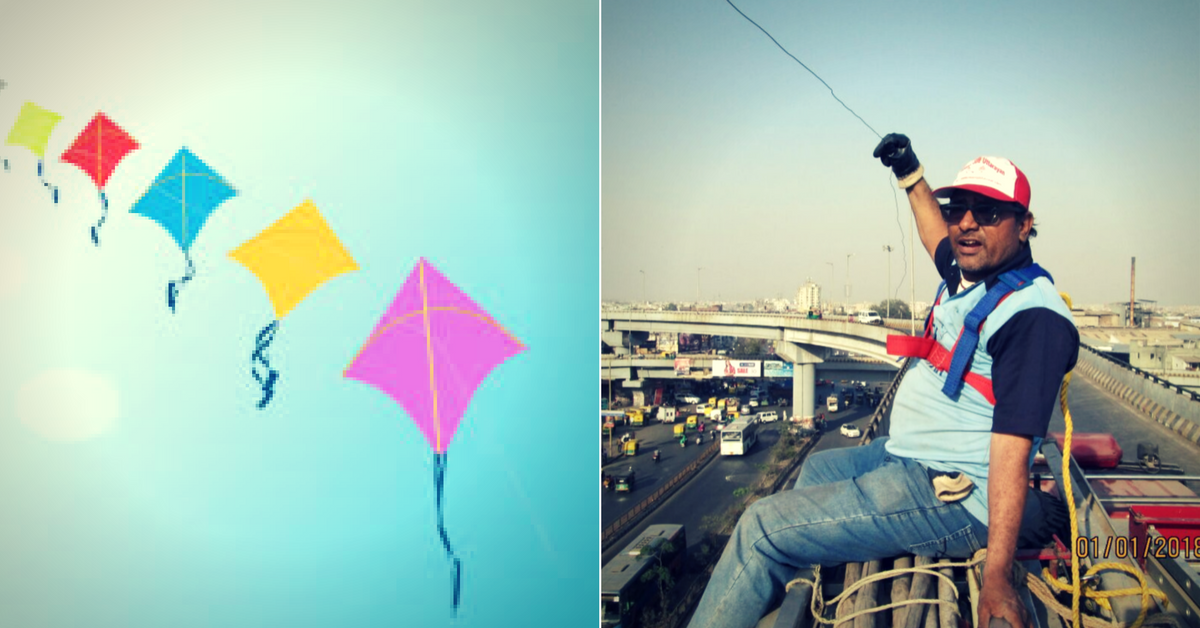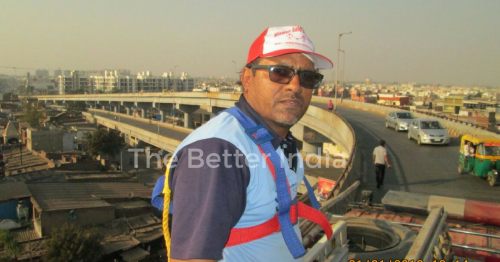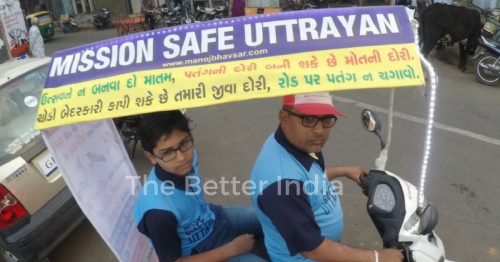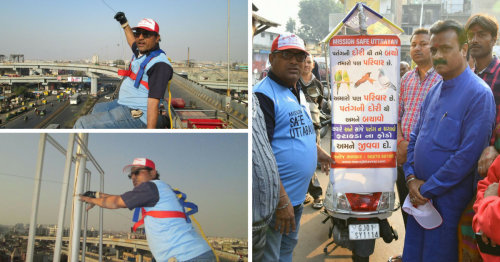How One Man Is Single-Handedly Making Ahmedabad’s Kite Festival Safer
Manoj Bhavsar noticed a chilling trend in the accidents occurring during Ahmedabad’s kite-festival. This is how he decided to help.

Manoj Bhavsar noticed a chilling trend in the accidents occurring during Ahmedabad’s kite-festival. This is how he decided to help.
It was on a cold morning in December 2006. Ahmedabad-resident Manoj Bhavsar, an air-conditioner technician, was heading towards his office on a two-wheeler when a stray kite string crossed his path. It came out of nowhere, almost slitting his neck.
“It was not a major injury, but I was scared. I kept thinking — what if it had cut my throat?” recalls Manoj.
Not long after, he built a simple protection device using a copper wire, which would save the driver and also the pillion rider.

The copper wire will sever any kite string that comes in contact with it, thus keeping the riders safe. “Initially, people used to laugh at me when I would put this wire on my bike and drive. But all I wanted was safety,” says Manoj. He was happy to fabricate similar copper wires for free, for the few people who did understand the importance of his precautionary action.
In December 2008, with the start of the annual International Kite Festival, Uttarayan, the Ahmedabad skyline was once again filled with the bright-coloured kites. Unfortunately, it was also time for an alarming statistic to be realised; 40% of the accidents that happened during this period were attributed to kite strings.
Preeti Ben Shah became the victim of one such accident and lost her life on the spot. Manoj became restless when he read the news. He wanted to do something to ensure safety of people who didn’t want to use safety wires on their vehicles. That was when he thought of fitting safety nets on over bridges to protect riders on the road from kite strings. “Usually, cut-off kites have a long manja attached to them and take a lot of time to reach the ground. With safety guards on over bridges, descending kite strings are blocked mid-way,” Manoj explains.
Since then, every year on Uttarayan, Manoj Bhavsar spearheads a project called ‘Mission Safe Uttarayan’.

He also became a volunteer for the helpline 108 and provided first-aid to injured people and birds. Nonetheless, his mission was difficult. There was virtually no support from the authorities. On the contrary, he had to regularly convince them to permit him to continue his task.
Finally his persistence was rewarded. His pleas compelled the Ahmedabad Municipal Corporation to give him permission to tie GI wires on all bridges of the city.
According to Manoj, he has to spend nearly Rs.1 lakh to do this every year.

So far, the technician has safe guarded 18 bridges in the city. He obtains permission from the municipality, seeks help from the fire brigade, hires hydraulics from a private agency and purchases the necessary copper wires — all using his own money.
Recently, he also invented a neck-band that can be worn during Uttarayan for additional safety.

“I just want everyone to be safe. Life is very precious, whether it is a human’s life or a bird’s,” he concludes.
For more information on his work or to contact Manoj Bhavsar, please log on to his website.
Like this story? Or have something to share? Write to us: [email protected], or connect with us on Facebook and Twitter.
NEW: Click here to get positive news on Whatsapp!
If you found our stories insightful, informative, or even just enjoyable, we invite you to consider making a voluntary payment to support the work we do at The Better India. Your contribution helps us continue producing quality content that educates, inspires, and drives positive change.
Choose one of the payment options below for your contribution-
By paying for the stories you value, you directly contribute to sustaining our efforts focused on making a difference in the world. Together, let’s ensure that impactful stories continue to be told and shared, enriching lives and communities alike.
Thank you for your support. Here are some frequently asked questions you might find helpful to know why you are contributing?


This story made me
- 97
- 121
- 89
- 167











